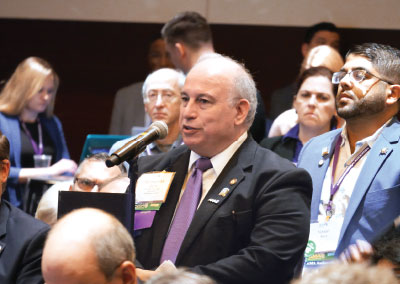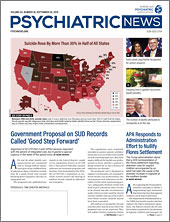APA and 46 other health care organizations say a proposed rule to change federal regulations governing confidentiality of substance abuse treatment records may be a good initial step toward breaking down regulatory barriers to integrated care.
The proposed rule, published last month in the Federal Register, would revise regulations known as 42 CFR Part 2 that govern federally assisted substance use treatment programs and facilities. First formulated in the 1970s, the 42 CFR Part 2 regulations as currently written restrict the sharing of medical records related to substance use treatment.
The regulations were originally intended to protect patient confidentiality, but in an era of electronic health records and integrated care, they have made it difficult for health care professionals to know whether a patient is being treated for or has a history of substance use disorder.
The proposed rule is designed to support coordinated care among different health care professionals who treat patients with substance use disorders (SUDs) while maintaining privacy safeguards: Patients would still need to give consent for their records to be shared, but the circumstances under which records could be shared and the number and type of providers with whom records could be shared have been expanded.
APA staff are reviewing the rule and said that there may be areas where the proposed rule can be improved. They will submit formal comments before the deadline on October 25.
In the meantime, APA joined with more than 46 other member organizations of the Partnership to Amend 42 CFR Part 2, saying the proposed rule could be an important step toward integrating mental and SUD treatment and general medical care for patients with SUD. The partnership has been calling for alignment of 42 CFR Part 2 with the Health Insurance Portability and Accountability Act (HIPAA) regulations to allow for information sharing by health care professionals involved in the care of patients with SUD.
“We appreciate the support provided by the administration to align 42 CFR Part 2 with HIPAA and its efforts through regulation to better allow information to flow between health care professionals to provide safer and better care for our patients with substance use disorders,” said APA CEO and Medical Director Saul Levin, M.D., M.P.A., in a press statement. “This is a good step forward in breaking down barriers for people with substance use disorders to receive effective integrated care. We will continue to work with the administration and Congress to address the remaining barriers.”
In June, the AMA House of Delegates voted to support alignment of 42 CFR Part 2 with HIPAA, a significant victory for the APA delegation, which sponsored the resolution approved by the House.
“What is most heartening about the passage of our resolution is the great support from other parts of the AMA,” Ken Certa, M.D., a member of the AMA Section Council on Psychiatry, told Psychiatric News after the June meeting. “There is a recognition that the outdated federal rules that mandate a separate chart for addiction treatment lead to incomplete information, which puts lives at risk.”
Updating the 42 CFR Part 2 regulations became necessary after the passage of HIPAA in 1996, but it gained urgency with the advent of the opioid crisis.
In the proposed rule published in the Federal Register, the Substance Abuse and Mental Health Services Administration (SAMHSA) noted that “laws and regulations governing the confidentiality of substance abuse records were originally written out of concern for the potential for misuse of those records against patients in treatment for a SUD.” The purpose of 42 CFR Part 2, SAMHSA explained, was to “ensure that patients receiving treatment for a substance use disorder … are not made more vulnerable to investigation or prosecution because of their association with a treatment program than they would be if they had not sought treatment.”
But SAMHSA added, “The emergence of the opioid crisis, with its catastrophic impact on individuals, families and caregivers, and corresponding clinical and safety challenges for providers, has highlighted the need for thoughtful updates to 42 CFR Part 2. ... SAMHSA believes [the proposed rule] would better align with the needs of individuals with SUD and of those who treat these patients in need and help facilitate the provision of well-coordinated care.” The proposed rule would make the following specific changes to 42 CFR Part 2:
•
Allow patients to consent to the disclosure of their information to a wide range of entities, without naming the specific individual receiving this information on behalf of a given entity. Special instructions would apply with respect to consent for disclosure of information to information exchanges and research institutions.
•
Allow disclosure of patient information to another Part 2 program or other SUD treatment provider during state or federally declared natural and major disasters. “SAMHSA believes this proposal would reduce the burden of disclosure requirements both for patients to receive, and for clinicians to provide, care that may not be otherwise feasible during natural and major disasters, ensuring that patients can continue to receive ongoing and appropriate care.”
•
Permit opioid treatment programs (OTPs) to disclose dispensing and prescribing data, as required by applicable state law, to state prescription drug monitoring programs (PDMPs), subject to patient consent, and allow nonopioid treatment providers to access these records. “[M]any drugs prescribed and dispensed by non-OTPs could have life-threatening and even deadly consequences if not properly coordinated with those prescribed and dispensed by OTPs,” SAMHSA wrote. “Therefore, SAMHSA believes it necessary for both OTPs and non-OTPs to report, and to access, prescription drug records in central registries and PDMPs and to monitor dosing accordingly.”
According to the Department of Health and Human Services (HHS), the proposed rule is the first of four regulations that have been identified in HHS’s “Regulatory Sprint to Coordinated Care,” which seeks to promote value-based outcomes for patients by examining federal regulations that impede coordinated care among health care professionals. ■
The proposed rule is posted
here. Information about the partnership is posted
here. A fact sheet prepared by the Department of Health and Human Services is posted
here. An FAQ prepared by SAMHSA is posted
here.

